Plasmasphere Refilling after the 1 June 2013 Geomagnetic Storm
Abstract
1. Introduction
2. Data and Methods
2.1. Plasma Mass Density
2.2. Solar Wind Parameters and Geomagnetic Activity Indices
2.3. Fit Profiles and PBL Inner Edge Evaluation
2.4. ZEAB Position Evaluation
3. Results
3.1. Observing the Plasmasphere Dynamics with EMMA
3.2. Day-to-Day Refilling
3.3. Diurnal Refilling
4. Discussion
5. Conclusions
- Inside the PBL, the flux tubes were not significantly depleted during the main phase, resulting in small refilling rates in all of the recovery phase.
- The region between the PBL and the ZEAB consisted of depleted flux tubes that corotated with the Earth. As suggested by Obana et al. [32], the resulting upward plasma flux during daytime was enhanced. As a result, the recovery of the plasmasphere took place principally in the region between the PBL and the ZEAB, and proceeded at an ever-increasing distance, until a new disturbance occurred.
- Outside the ZEAB, the plasma supplied by the ionosphere could not be sufficiently trapped, and was lost through convection towards the magnetopause. As pointed out by Denton et al. [42], the observed density variation may not be the result of refilling of a particular flux tube. This is especially true well outside the ZEAB, where the plasma typically does not corotate with the Earth, and what we see is the plasma density sampled at different moments on different drift paths. Strictly speaking, the refilling concept is not applicable to the region outside the ZEAB, with the exception of the post-dawn sector, when the flux tubes convecting from the nightside might corotate with the Earth [35], and be filled with ionospheric plasma for a few hours before they are lost to the magnetopause, e.g., [88]. However, it is worth noting that because of the plasma loss, an analysis of this region will result in an apparently smaller diurnal refilling rate.
Author Contributions
Funding
Data Availability Statement
Acknowledgments
Conflicts of Interest
Abbreviations
| EMMA | European quasi-Meridional Magnetometer Array |
| EUV | Extreme Ultraviolet Imager |
| FLR | Field Line Resonance |
| GNSS | Global Navigation Satellite Systems |
| GSM | Geocentric Solar Magnetospheric (coordinate system) |
| MHD | Magnetohydrodynamics |
| IMAGE | Imager for Magnetopause-to-Aurora Global Exploration |
| IMF | Interplanetary Magnetic Field |
| LT | Local Time |
| MLT | Magnetic Local Time |
| PBL | Plasmasphere Boundary Layer |
| RIMS | Retarding Ion Mass Spectrometer |
| RPI | Radio Plasma Imager |
| ULF | Ultra-Low Frequency |
| UT | Universal Time |
| VLF | Very Low Frequency |
| ZEAB | Zero-Energy Alfvén Boundary |
References
- Chappell, C.R. The Role of the Ionosphere in Providing Plasma to the Terrestrial Magnetosphere—An Historical Overview. Space Sci. Rev. 2015, 192, 5–25. [Google Scholar] [CrossRef]
- Carpenter, D.L.; Lemaire, J. The Plasmasphere Boundary Layer. Ann. Geophys. 2004, 22, 4291–4298. [Google Scholar] [CrossRef]
- Axford, W.I.; Hines, C.O. A unifying theory of high-latitude geophysical phenomena and geomagnetic storms. Can. J. Phys. 1961, 39, 1433–1464. [Google Scholar] [CrossRef]
- Nishida, A. Formation of plasmapause, or magnetospheric plasma knee, by the combined action of magnetospheric convection and plasma escape from the tail. J. Geophys. Res. (1896–1977) 1966, 71, 5669–5679. [Google Scholar] [CrossRef]
- Grebowsky, J.M. Model study of plasmapause motion. J. Geophys. Res. (1896–1977) 1970, 75, 4329–4333. [Google Scholar] [CrossRef]
- Hones, E.W., Jr.; Bergeson, J.E. Electric field generated by a rotating magnetized sphere. J. Geophys. Res. (1896–1977) 1965, 70, 4951–4958. [Google Scholar] [CrossRef]
- Dungey, J.W. Interplanetary Magnetic Field and the Auroral Zones. Phys. Rev. Lett. 1961, 6, 47–48. [Google Scholar] [CrossRef]
- McIlwain, C.E. Coordinates for mapping the distribution of magnetically trapped particles. J. Geophys. Res. (1896–1977) 1961, 66, 3681–3691. [Google Scholar] [CrossRef]
- Vasyliunas, V.M. A crude estimate of the relation between the solar wind speed and the magnetospheric electric field. J. Geophys. Res. (1896–1977) 1968, 73, 2529–2530. [Google Scholar] [CrossRef]
- Rowland, D.E.; Wygant, J.R. Dependence of the large-scale, inner magnetospheric electric field on geomagnetic activity. J. Geophys. Res. Space Phys. 1998, 103, 14959–14964. [Google Scholar] [CrossRef]
- Nishida, A. Coherence of geomagnetic DP 2 fluctuations with interplanetary magnetic variations. J. Geophys. Res. (1896–1977) 1968, 73, 5549–5559. [Google Scholar] [CrossRef]
- Reinisch, B.W.; Moldwin, M.B.; Denton, R.E.; Gallagher, D.L.; Matsui, H.; Pierrard, V.; Tu, J. Augmented empirical models of plasmaspheric density and electric field using IMAGE and CLUSTER data. Space Sci. Rev. 2009, 145, 231–261. [Google Scholar] [CrossRef]
- Volland, H. A semiempirical model of large-scale magnetospheric electric fields. J. Geophys. Res. (1896–1977) 1973, 78, 171–180. [Google Scholar] [CrossRef]
- Stern, D.P. The motion of a proton in the equatorial magnetosphere. J. Geophys. Res. (1896–1977) 1975, 80, 595–599. [Google Scholar] [CrossRef]
- Southwood, D.J. The role of hot plasma in magnetospheric convection. J. Geophys. Res. (1896–1977) 1977, 82, 5512–5520. [Google Scholar] [CrossRef]
- Southwood, D.; Kaye, S. Drift boundary approximations in simple magnetospheric convection models. J. Geophys. Res. Space Phys. 1979, 84, 5773–5780. [Google Scholar] [CrossRef]
- Ejiri, M. Trajectory traces of charged particles in the magnetosphere. J. Geophys. Res. Space Phys. 1978, 83, 4798–4810. [Google Scholar] [CrossRef]
- Maynard, N.C.; Chen, A.J. Isolated cold plasma regions: Observations and their relation to possible production mechanisms. J. Geophys. Res. (1896–1977) 1975, 80, 1009–1013. [Google Scholar] [CrossRef]
- McIlwain, C. A Kp dependent equatorial electric field model. Adv. Space Res. 1986, 6, 187–197. [Google Scholar] [CrossRef]
- Carpenter, D.L. Whistler evidence of a ‘knee’ in the magnetospheric ionization density profile. J. Geophys. Res. (1896–1977) 1963, 68, 1675–1682. [Google Scholar] [CrossRef]
- Chappell, C.R.; Fields, S.A.; Baugher, C.R.; Hoffman, J.H.; Hanson, W.B.; Wright, W.W.; Hammack, H.D.; Carignan, G.R.; Nagy, A.F. The retarding ion mass spectrometer on Dynamics Explorer-A. Space Sci. Instrum. 1981, 5, 477–491. [Google Scholar]
- Chandler, M.O.; Chappell, C.R. Observations of the flow of H+ and He+ along magnetic field lines in the plasmasphere. J. Geophys. Res. Space Phys. 1986, 91, 8847–8860. [Google Scholar] [CrossRef]
- Sandel, B.R.; Broadfoot, A.L.; Curtis, C.C.; King, R.A.; Stone, T.C.; Hill, R.H.; Chen, J.; Siegmund, O.H.W.; Raffanti, R.; Allred, D.D.; et al. The Extreme Ultraviolet Imager Investigation for the IMAGE Mission. In The Image Mission; Burch, J.L., Ed.; Springer: Dordrecht, The Netherlands, 2000; pp. 197–242. [Google Scholar] [CrossRef]
- Park, C.G. Some features of plasma distribution in the plasmasphere deduced from Antarctic whistlers. J. Geophys. Res. 1974, 79, 169–173. [Google Scholar] [CrossRef]
- Park, C.G.; Carpenter, D.L.; Wiggin, D.B. Electron density in the plasmasphere: Whistler data on solar cycle, annual, and diurnal variations. J. Geophys. Res. Space Phys. 1978, 83, 3137–3144. [Google Scholar] [CrossRef]
- Menk, F.W.; Orr, D.; Clilverd, M.A.; Smith, A.J.; Waters, C.L.; Milling, D.K.; Fraser, B.J. Monitoring spatial and temporal variations in the dayside plasmasphere using geomagnetic field line resonances. J. Geophys. Res. Space Phys. 1999, 104, 19955–19969. [Google Scholar] [CrossRef]
- Menk, F.; Kale, Z.; Sciffer, M.; Robinson, P.; Waters, C.; Grew, R.; Clilverd, M.; Mann, I. Remote sensing the plasmasphere, plasmapause, plumes and other features using ground-based magnetometers. J. Space Weather Space Clim. 2014, 4, A34. [Google Scholar] [CrossRef]
- Sandel, B.R.; Goldstein, J.; Gallagher, D.L.; Spasojevic, M. Extreme ultraviolet imager observations of the structure and dynamics of the plasmasphere. Space Sci. Rev. 2003, 109, 25–46. [Google Scholar] [CrossRef]
- Carpenter, D.; Lemaire, J. Erosion and Recovery of the Plasmasphere in the Plasmapause Region. Space Sci. Rev. 1997, 80, 153–179. [Google Scholar] [CrossRef]
- Thorne, R.M. Radiation belt dynamics: The importance of wave-particle interactions. Geophys. Res. Lett. 2010, 37, L22107. [Google Scholar] [CrossRef]
- Gallagher, D.L.; Comfort, R.H. Unsolved problems in plasmasphere refilling. J. Geophys. Res. Space Phys. 2016, 121, 1447–1451. [Google Scholar] [CrossRef]
- Obana, Y.; Menk, F.W.; Yoshikawa, I. Plasma refilling rates for L = 2.3–3.8 flux tubes. J. Geophys. Res. Space Phys. 2010, 115, A03204. [Google Scholar] [CrossRef]
- Goldstein, J.; Sandel, B.R.; Forrester, W.T.; Reiff, P.H. IMF-driven plasmasphere erosion of 10 July 2000. Geophys. Res. Lett. 2003, 30, 1146. [Google Scholar] [CrossRef]
- Rasmussen, C.E.; Guiter, S.M.; Thomas, S.G. A two-dimensional model of the plasmasphere: Refilling time constants. Planet. Space Sci. 1993, 41, 35–43. [Google Scholar] [CrossRef]
- Reinisch, B.W.; Huang, X.; Song, P.; Green, J.L.; Fung, S.F.; Vasyliunas, V.M.; Gallagher, D.L.; Sandel, B.R. Plasmaspheric mass loss and refilling as a result of a magnetic storm. J. Geophys. Res. Space Phys. 2004, 109, A01202. [Google Scholar] [CrossRef]
- Dent, Z.C.; Mann, I.R.; Goldstein, J.; Menk, F.W.; Ozeke, L.G. Plasmaspheric depletion, refilling, and plasmapause dynamics: A coordinated ground-based and IMAGE satellite study. J. Geophys. Res. Space Phys. 2006, 111, A03205. [Google Scholar] [CrossRef]
- Sandel, B.R.; Denton, M.H. Global view of refilling of the plasmasphere. Geophys. Res. Lett. 2007, 34, L17102. [Google Scholar] [CrossRef]
- Carpenter, D.L.; Anderson, R.R. An ISEE/whistler model of equatorial electron density in the magnetosphere. J. Geophys. Res. Space Phys. 1992, 97, 1097–1108. [Google Scholar] [CrossRef]
- Gallagher, D.L.; Comfort, R.H.; Katus, R.M.; Sandel, B.R.; Fung, S.F.; Adrian, M.L. The Breathing Plasmasphere: Erosion and Refilling. J. Geophys. Res. Space Phys. 2021, 126, e2020JA028727. [Google Scholar] [CrossRef]
- Singh, N.; Horwitz, J.L. Plasmasphere refilling: Recent observations and modeling. J. Geophys. Res. Space Phys. 1992, 97, 1049–1079. [Google Scholar] [CrossRef]
- Denton, R.E.; Wang, Y.; Webb, P.A.; Tengdin, P.M.; Goldstein, J.; Redfern, J.A.; Reinisch, B.W. Magnetospheric electron density long-term (>1 day) refilling rates inferred from passive radio emissions measured by IMAGE RPI during geomagnetically quiet times. J. Geophys. Res. Space Phys. 2012, 117, A03221. [Google Scholar] [CrossRef]
- Denton, R.E.; Takahashi, K.; Amoh, J.; Singer, H.J. Mass density at geostationary orbit and apparent mass refilling. J. Geophys. Res. Space Phys. 2016, 121, 2962–2975. [Google Scholar] [CrossRef]
- Chi, P.J.; Russell, C.T.; Musman, S.; Peterson, W.K.; Le, G.; Angelopoulos, V.; Reeves, G.D.; Moldwin, M.B.; Chun, F.K. Plasmaspheric depletion and refilling associated with the September 25, 1998 magnetic storm observed by ground magnetometers at L=2. Geophys. Res. Lett. 2000, 27, 633–636. [Google Scholar] [CrossRef]
- Lichtenberger, J.; Clilverd, M.A.; Heilig, B.; Vellante, M.; Manninen, J.; Rodger, C.J.; Collier, A.B.; Jørgensen, A.M.; Reda, J.; Holzworth, R.H.; et al. The plasmasphere during a space weather event: First results from the PLASMON project. J. Space Weather Space Clim. 2013, 3, A23. [Google Scholar] [CrossRef]
- Huba, J.; Krall, J. Modeling the plasmasphere with SAMI3. Geophys. Res. Lett. 2013, 40, 6–10. [Google Scholar] [CrossRef]
- Krall, J.; Huba, J.D. SAMI3 simulation of plasmasphere refilling. Geophys. Res. Lett. 2013, 40, 2484–2488. [Google Scholar] [CrossRef]
- Jorgensen, A.; Ober, D.; Koller, J.; Friedel, R. Specification of the Earth’s plasmasphere with data assimilation. Adv. Space Res. 2011, 47, 2152–2161. [Google Scholar] [CrossRef]
- Jorgensen, A.M.; Heilig, B.; Vellante, M.; Lichtenberger, J.; Reda, J.; Valach, F.; Mandic, I. Comparing the Dynamic Global Core Plasma Model with ground-based plasma mass density observations. J. Geophys. Res. Space Phys. 2017, 122, 7997–8013. [Google Scholar] [CrossRef]
- Maruyama, N.; Sun, Y.Y.; Richards, P.G.; Middlecoff, J.; Fang, T.W.; Fuller-Rowell, T.J.; Akmaev, R.A.; Liu, J.Y.; Valladares, C.E. A new source of the midlatitude ionospheric peak density structure revealed by a new Ionosphere-Plasmasphere model. Geophys. Res. Lett. 2016, 43, 2429–2435. [Google Scholar] [CrossRef]
- Milling, D.K.; Mann, I.R.; Menk, F.W. Diagnosing the plasmapause with a network of closely spaced ground-based magnetometers. Geophys. Res. Lett. 2001, 28, 115–118. [Google Scholar] [CrossRef]
- Menk, F.W.; Mann, I.R.; Smith, A.J.; Waters, C.L.; Clilverd, M.A.; Milling, D.K. Monitoring the plasmapause using geomagnetic field line resonances. J. Geophys. Res. Space Phys. 2004, 109, A04216. [Google Scholar] [CrossRef]
- Del Corpo, A.; Vellante, M.; Heilig, B.; Pietropaolo, E.; Reda, J.; Lichtenberger, J. An Empirical Model for the Dayside Magnetospheric Plasma Mass Density Derived From EMMA Magnetometer Network Observations. J. Geophys. Res. Space Phys. 2020, 125, e2019JA027381. [Google Scholar] [CrossRef]
- Del Corpo, A.; Vellante, M.; Heilig, B.; Pietropaolo, E.; Reda, J.; Lichtenberger, J. Observing the cold plasma in the Earth’s magnetosphere with the EMMA network. Ann. Geophys. 2019, 62, GM447. [Google Scholar] [CrossRef]
- Del Corpo, A.; Vellante, M.; Zhelavskaya, I.S.; Shprits, Y.Y.; Heilig, B.; Reda, J.; Pietropaolo, E.; Lichtenberger, J. Study of the Average Ion Mass of the Dayside Magnetospheric Plasma. J. Geophys. Res. Space Phys. 2022, 127, e2022JA030605. [Google Scholar] [CrossRef]
- Baransky, L.; Borovkov, J.; Gokhberg, M.; Krylov, S.; Troitskaya, V. High resolution method of direct measurement of the magnetic field lines’ eigen frequencies. Planet. Space Sci. 1985, 33, 1369–1374. [Google Scholar] [CrossRef]
- Waters, C.L.; Menk, F.W.; Fraser, B.J. The resonance structure of low latitude Pc3 geomagnetic pulsations. Geophys. Res. Lett. 1991, 18, 2293–2296. [Google Scholar] [CrossRef]
- Singer, H.; Southwood, D.; Walker, R.; Kivelson, M. Alfvén wave resonances in a realistic magnetospheric magnetic field geometry. J. Geophys. Res. Space Phys. 1981, 86, 4589–4596. [Google Scholar] [CrossRef]
- Waters, C.L.; Samson, J.C.; Donovan, E.F. The temporal variation of the frequency of high latitude field line resonances. J. Geophys. Res. Space Phys. 1995, 100, 7987–7996. [Google Scholar] [CrossRef]
- Tsyganenko, N.A.; Sitnov, M.I. Modeling the dynamics of the inner magnetosphere during strong geomagnetic storms. J. Geophys. Res. Space Phys. 2005, 110, A03208. [Google Scholar] [CrossRef]
- Alken, P.; Thébault, E.; Beggan, C.D.; Amit, H.; Aubert, J.; Baerenzung, J.; Bondar, T.; Brown, W.; Califf, S.; Chambodut, A.; et al. International geomagnetic reference field: The thirteenth generation. Earth Planets Space 2021, 73, 1–25. [Google Scholar] [CrossRef]
- Berube, D.; Moldwin, M.B.; Ahn, M. Computing magnetospheric mass density from field line resonances in a realistic magnetic field geometry. J. Geophys. Res. Space Phys. 2006, 111, A08206. [Google Scholar] [CrossRef]
- Vellante, M.; Piersanti, M.; Heilig, B.; Reda, J.; Del Corpo, A. Magnetospheric plasma density inferred from field line resonances: Effects of using different magnetic field models. In Proceedings of the 2014 XXXIth URSI General Assembly and Scientific Symposium (URSI GASS), Beijing, China, 16–23 August 2014; pp. 1–4. [Google Scholar] [CrossRef]
- Chi, P.J.; Engebretson, M.J.; Moldwin, M.B.; Russell, C.T.; Mann, I.R.; Hairston, M.R.; Reno, M.; Goldstein, J.; Winkler, L.I.; Cruz-Abeyro, J.L.; et al. Sounding of the plasmasphere by Mid-continent MAgnetoseismic Chain (McMAC) magnetometers. J. Geophys. Res. Space Phys. 2013, 118, 3077–3086. [Google Scholar] [CrossRef]
- Allan, W.; Knox, F. A dipole field model for axisymmetric alfvén waves with finite ionosphere conductivities. Planet. Space Sci. 1979, 27, 79–85. [Google Scholar] [CrossRef]
- Obana, Y.; Menk, F.W.; Sciffer, M.D.; Waters, C.L. Quarter-wave modes of standing Alfvén waves detected by cross-phase analysis. J. Geophys. Res. Space Phys. 2008, 113, A08203. [Google Scholar] [CrossRef]
- Obana, Y.; Waters, C.L.; Sciffer, M.D.; Menk, F.W.; Lysak, R.L.; Shiokawa, K.; Hurst, A.W.; Petersen, T. Resonance structure and mode transition of quarter-wave ULF pulsations around the dawn terminator. J. Geophys. Res. Space Phys. 2015, 120, 4194–4212. [Google Scholar] [CrossRef]
- Takahashi, K.; Vellante, M.; Del Corpo, A.; Claudepierre, S.G.; Kletzing, C.; Wygant, J.; Koga, K. Multiharmonic Toroidal Standing Alfvén Waves in the Midnight Sector Observed During a Geomagnetically Quiet Period. J. Geophys. Res. Space Phys. 2020, 125, e2019JA027370. [Google Scholar] [CrossRef]
- Regi, M.; Perrone, L.; Del Corpo, A.; Spogli, L.; Sabbagh, D.; Cesaroni, C.; Alfonsi, L.; Bagiacchi, P.; Cafarella, L.; Carnevale, G.; et al. Space Weather Effects Observed in the Northern Hemisphere during November 2021 Geomagnetic Storm: The Impacts on Plasmasphere, Ionosphere and Thermosphere Systems. Remote Sens. 2022, 14, 5765. [Google Scholar] [CrossRef]
- Ozeke, L.G.; Mann, I.R. High and low ionospheric conductivity standing guided Alfvén wave eigenfrequencies: A model for plasma density mapping. J. Geophys. Res. Space Phys. 2005, 110, A04215. [Google Scholar] [CrossRef]
- Vellante, M.; Förster, M. Inference of the magnetospheric plasma mass density from field line resonances: A test using a plasmasphere model. J. Geophys. Res. Space Phys. 2006, 111, A11204. [Google Scholar] [CrossRef]
- Takahashi, K.; Denton, R.E.; Anderson, R.R.; Hughes, W.J. Frequencies of standing Alfvén wave harmonics and their implication for plasma mass distribution along geomagnetic field lines: Statistical analysis of CRRES data. J. Geophys. Res. Space Phys. 2004, 109, A08202. [Google Scholar] [CrossRef]
- Denton, R.E.; Takahashi, K.; Galkin, I.A.; Nsumei, P.A.; Huang, X.; Reinisch, B.W.; Anderson, R.R.; Sleeper, M.K.; Hughes, W.J. Distribution of density along magnetospheric field lines. J. Geophys. Res. Space Phys. 2006, 111, A04213. [Google Scholar] [CrossRef]
- Takahashi, K.; Denton, R.E. Nodal Structure of Toroidal Standing Alfvén Waves and Its Implication for Field Line Mass Density Distribution. J. Geophys. Res. Space Phys. 2021, 126, e2020JA028981. [Google Scholar] [CrossRef]
- Vellante, M.; Takahashi, K.; Del Corpo, A.; Zhelavskaya, I.S.; Goldstein, J.; Mann, I.R.; Pietropaolo, E.; Reda, J.; Heilig, B. Multi-Instrument Characterization of Magnetospheric Cold Plasma Dynamics in the June 22, 2015 Geomagnetic Storm. J. Geophys. Res. Space Phys. 2021, 126, e2021JA029292. [Google Scholar] [CrossRef] [PubMed]
- Waters, C.; Kabin, K.; Rankin, R.; Donovan, E.; Samson, J. Effects of the magnetic field model and wave polarisation on the estimation of proton number densities in the magnetosphere using field line resonances. Planet. Space Sci. 2007, 55, 809–819. [Google Scholar] [CrossRef]
- Kawano, H.; Yumoto, K.; Pilipenko, V.A.; Tanaka, Y.M.; Takasaki, S.; Iizima, M.; Seto, M. Using two ground stations to identify magnetospheric field line eigenfrequency as a continuous function of ground latitude. J. Geophys. Res. Space Phys. 2002, 107, SMP 25-1–SMP 25-12. [Google Scholar] [CrossRef]
- Fraser, B.J.; Horwitz, J.L.; Slavin, J.A.; Dent, Z.C.; Mann, I.R. Heavy ion mass loading of the geomagnetic field near the plasmapause and ULF wave implications. Geophys. Res. Lett. 2005, 32, L04102. [Google Scholar] [CrossRef]
- Roberts, W.T., Jr.; Horwitz, J.L.; Comfort, R.H.; Chappell, C.R.; Waite, J.H., Jr.; Green, J.L. Heavy ion density enhancements in the outer plasmasphere. J. Geophys. Res. Space Phys. 1987, 92, 13499–13512. [Google Scholar] [CrossRef]
- Poulter, E.; Allan, W. Transient ULF pulsation decay rates observed by ground based magnetometers: The contribution of spatial integration. Planet. Space Sci. 1985, 33, 607–616. [Google Scholar] [CrossRef]
- Shue, J.H.; Song, P.; Russell, C.T.; Steinberg, J.T.; Chao, J.K.; Zastenker, G.; Vaisberg, O.L.; Kokubun, S.; Singer, H.J.; Detman, T.R.; et al. Magnetopause location under extreme solar wind conditions. J. Geophys. Res. Space Phys. 1998, 103, 17691–17700. [Google Scholar] [CrossRef]
- Burke, W.J. Penetration electric fields: A Volland–Stern approach. J. Atmos. Sol.-Terr. Phys. 2007, 69, 1114–1126. [Google Scholar] [CrossRef]
- Chappell, C.R. Recent satellite measurements of the morphology and dynamics of the plasmasphere. Rev. Geophys. 1972, 10, 951–979. [Google Scholar] [CrossRef]
- Chi, P.J.; Russell, C.T.; Foster, J.C.; Moldwin, M.B.; Engebretson, M.J.; Mann, I.R. Density enhancement in plasmasphere-ionosphere plasma during the 2003 Halloween Superstorm: Observations along the 330th magnetic meridian in North America. Geophys. Res. Lett. 2005, 32, L03S07. [Google Scholar] [CrossRef]
- Krall, J.; Huba, J.D.; Denton, R.E.; Crowley, G.; Wu, T.W. The effect of the thermosphere on quiet time plasmasphere morphology. J. Geophys. Res. Space Phys. 2014, 119, 5032–5048. [Google Scholar] [CrossRef]
- Burch, J. IMAGE mission overview. Space Sci. Rev. 2000, 91, 1–14. [Google Scholar] [CrossRef]
- Galvan, D.A.; Moldwin, M.B.; Sandel, B.R.; Crowley, G. On the causes of plasmaspheric rotation variability: IMAGE EUV observations. J. Geophys. Res. Space Phys. 2010, 115, A01214. [Google Scholar] [CrossRef]
- Chappell, C.R.; Huddleston, M.M.; Moore, T.E.; Giles, B.L.; Delcourt, D.C. Observations of the warm plasma cloak and an explanation of its formation in the magnetosphere. J. Geophys. Res. Space Phys. 2008, 113, A09206. [Google Scholar] [CrossRef]
- Higel, B.; Lei, W. Electron density and plasmapause characteristics at 6.6 RE: A statistical study of the GEOS 2 relaxation sounder data. J. Geophys. Res. Space Phys. 1984, 89, 1583–1601. [Google Scholar] [CrossRef]

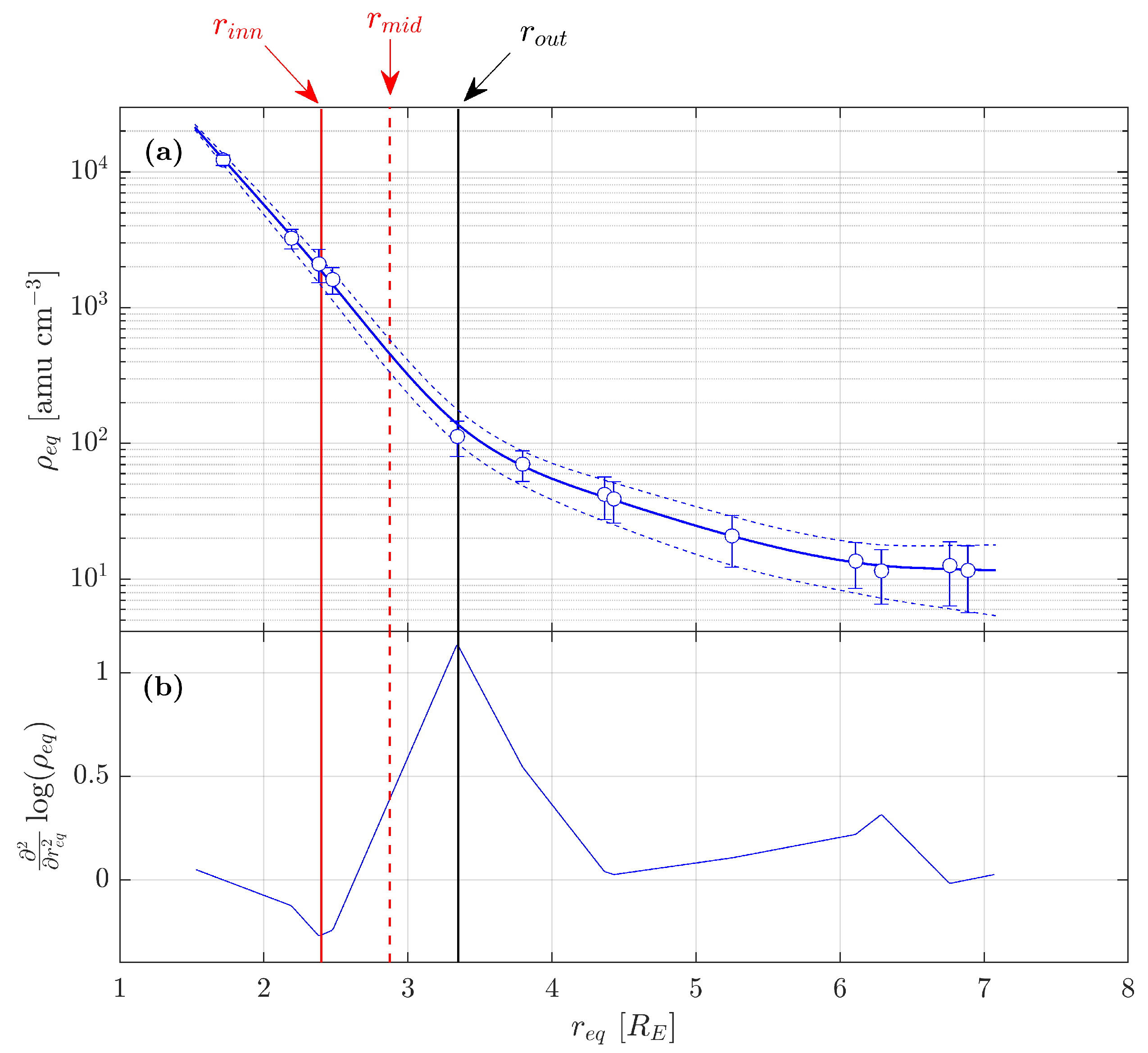
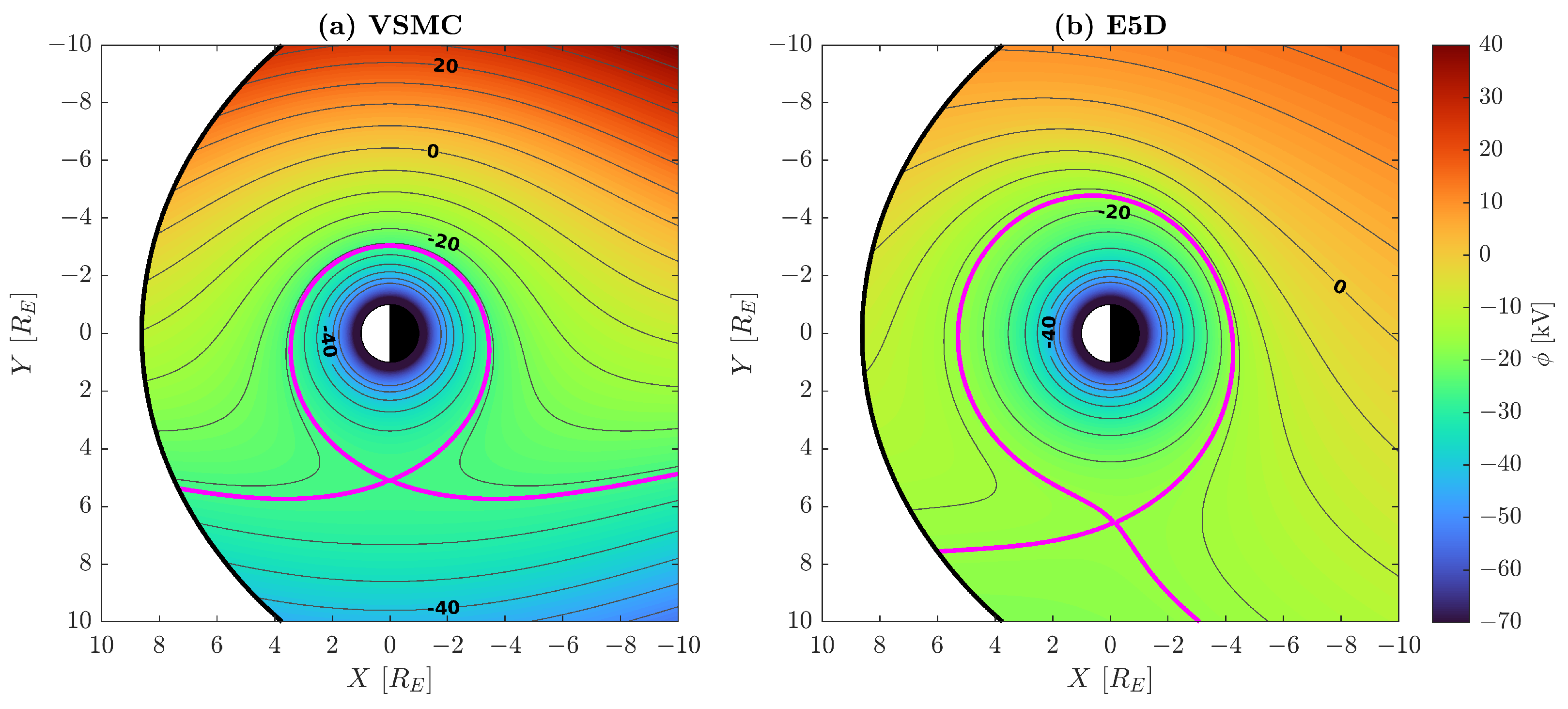
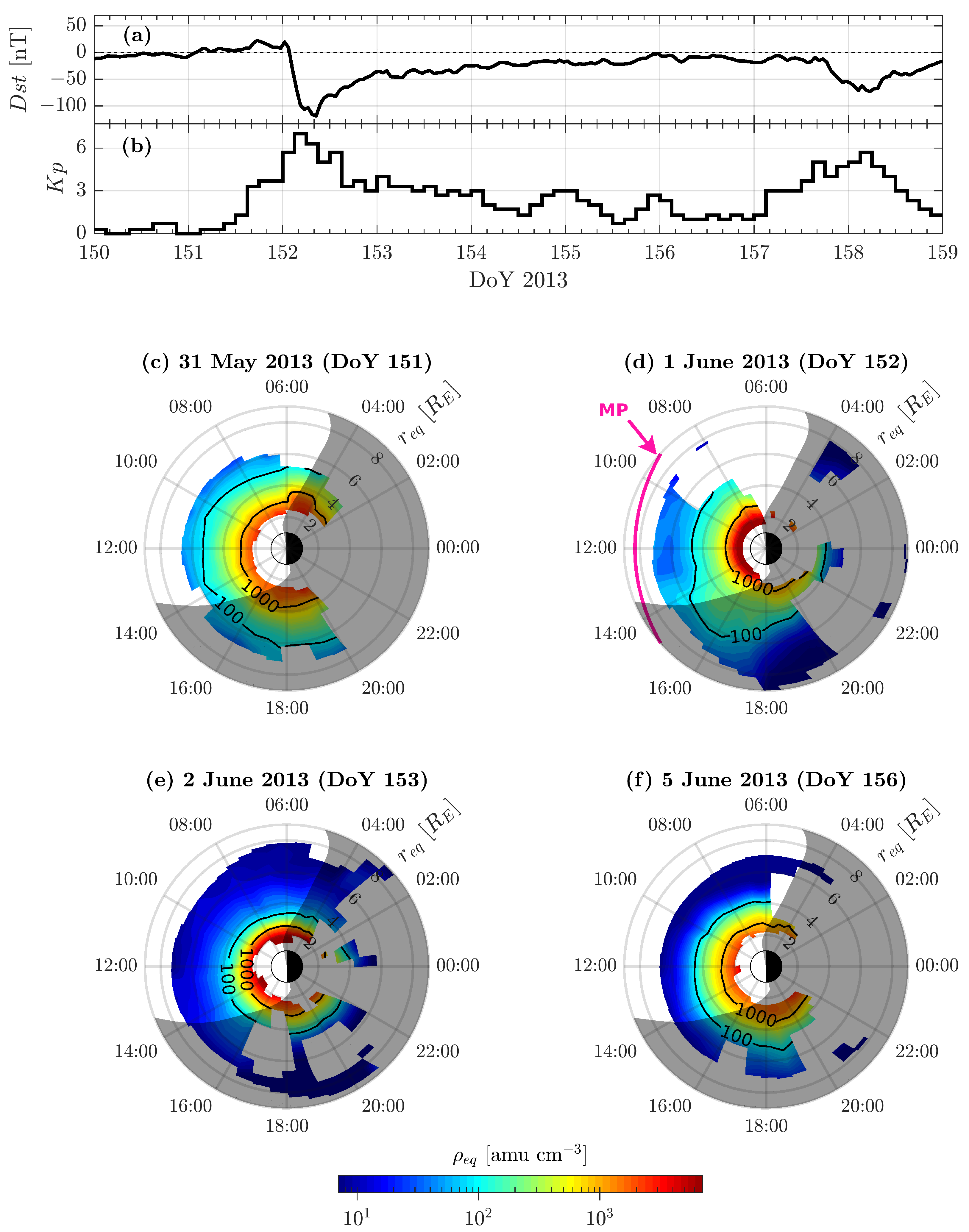
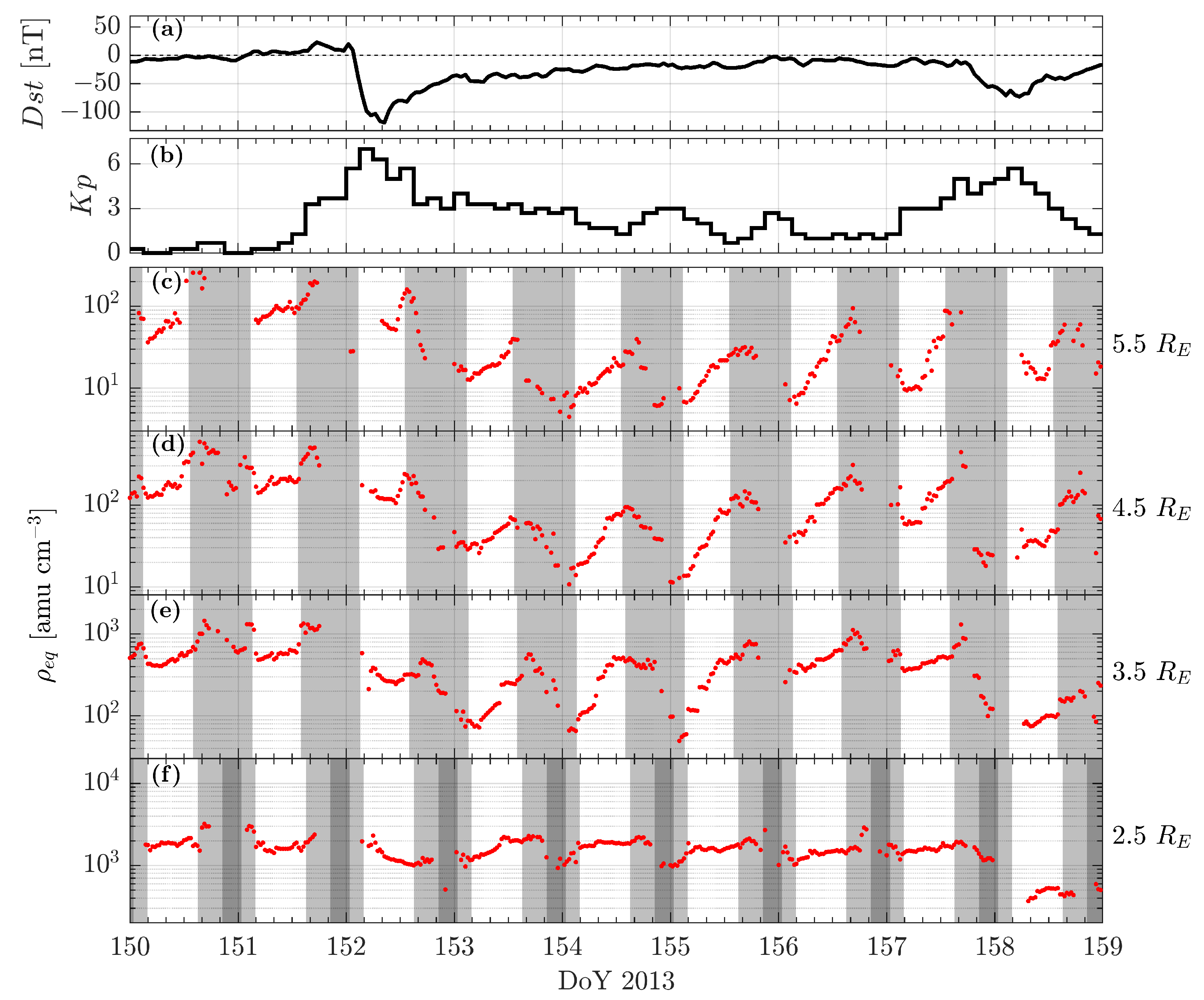
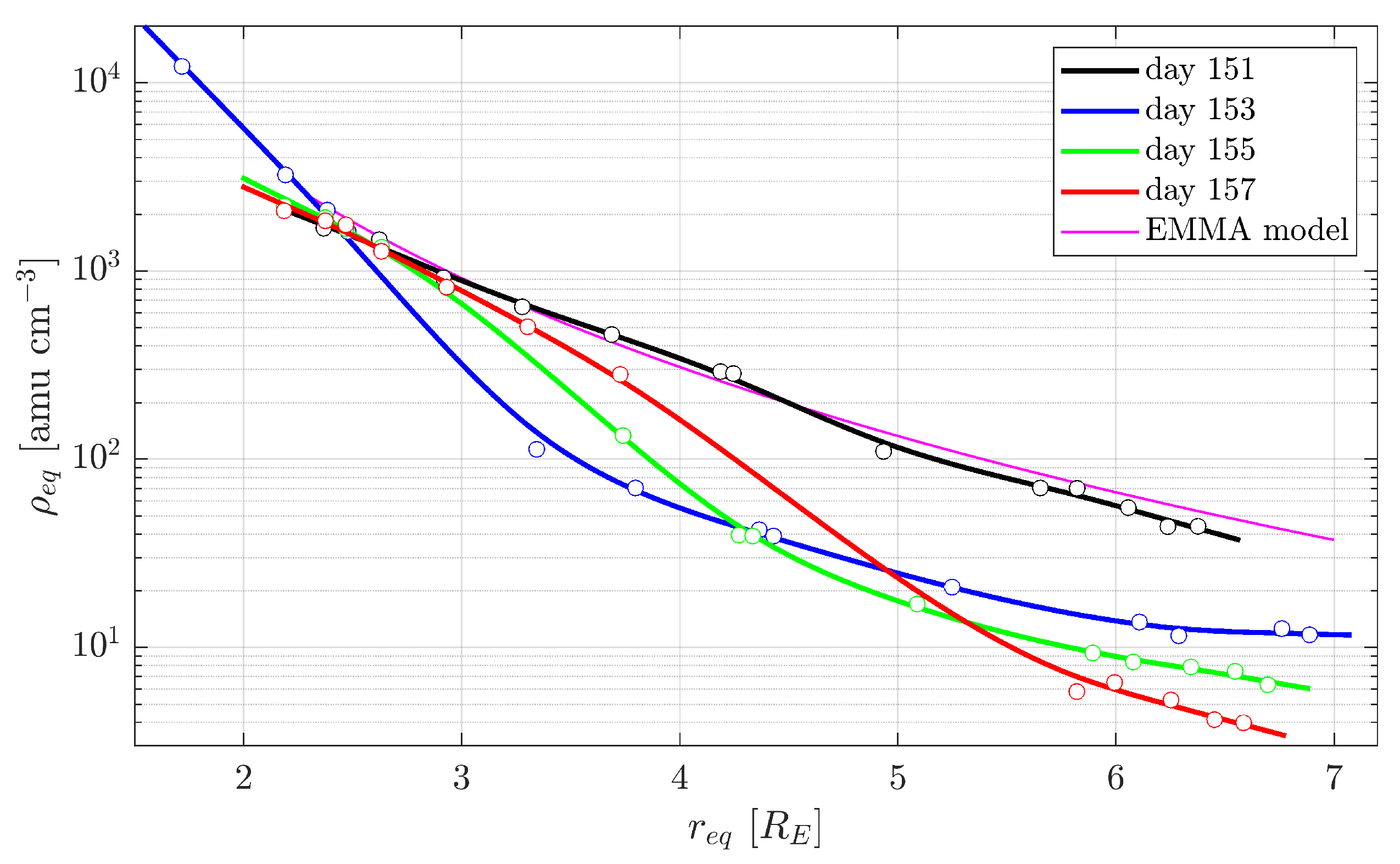
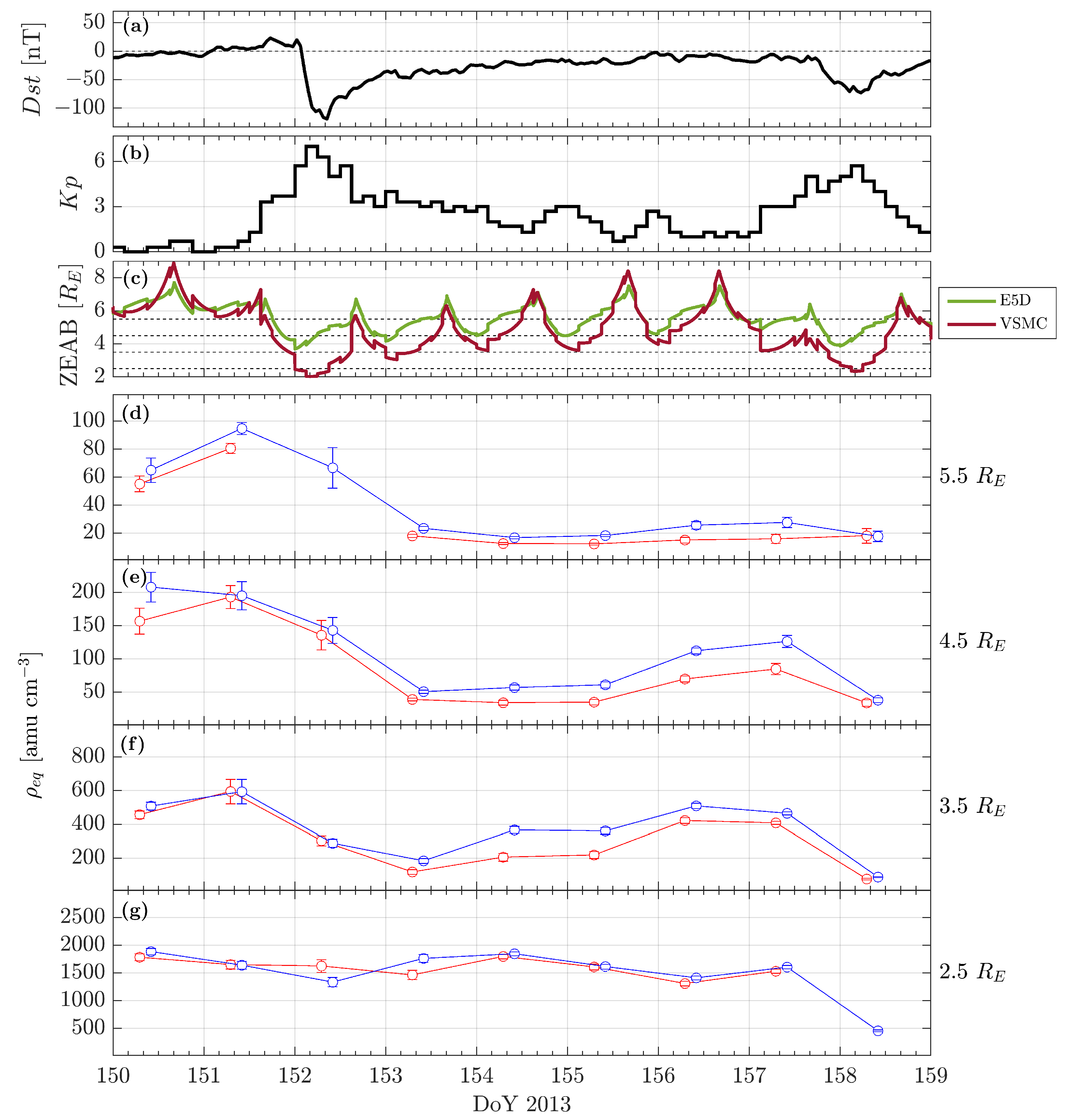
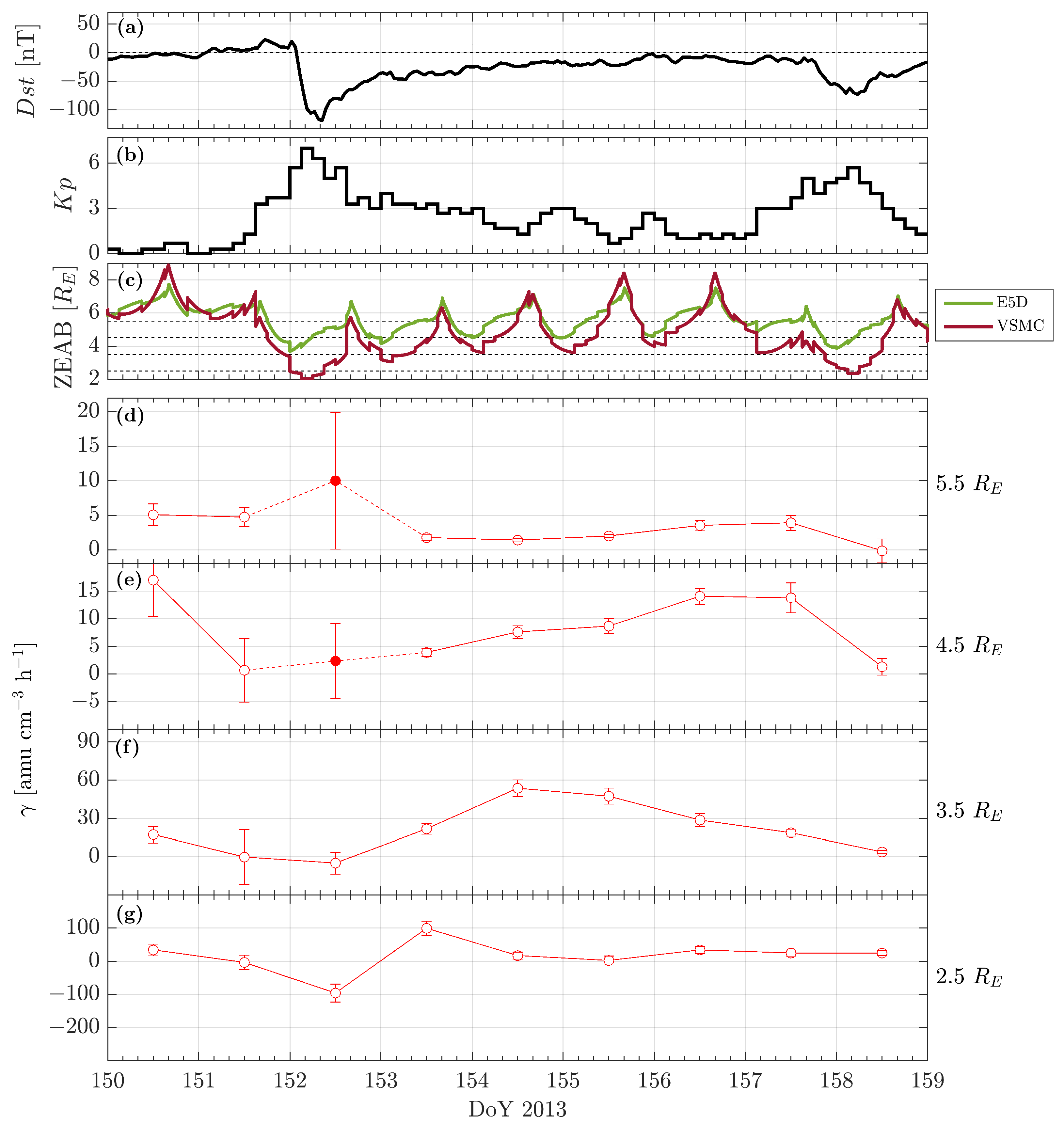
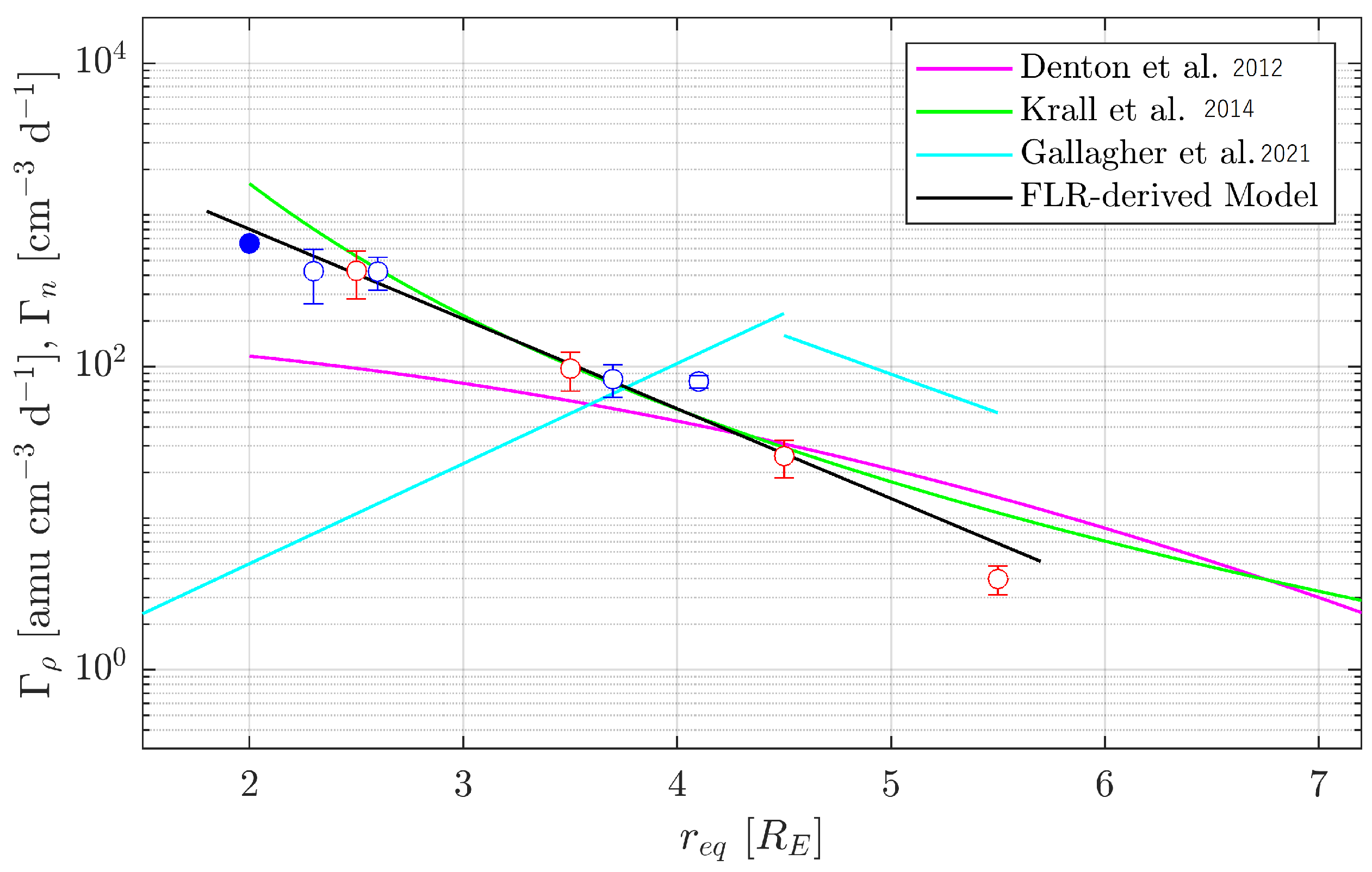
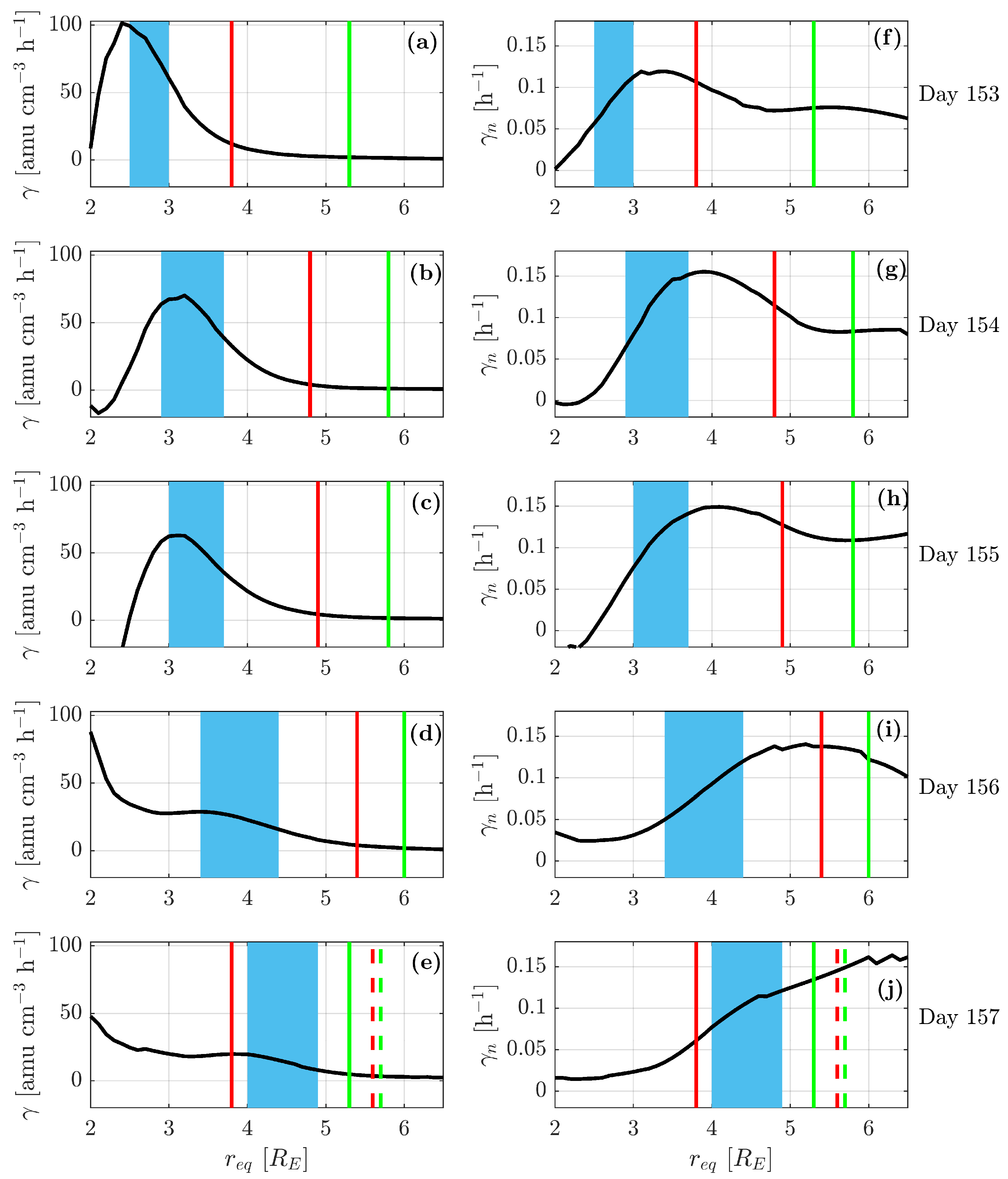
| Day 153 | Day 154 | Day 155 | Day 156 | Day 157 | |
|---|---|---|---|---|---|
| [] | 2.5 | 2.9 | 3.0 | 3.4 | 4.0 |
| [] | 3.0 | 3.7 | 3.7 | 4.4 | 4.9 |
| [] | [amu cm d] | MLT Sector | Source |
|---|---|---|---|
| 3.5 | 09:00 | our observations | |
| 4.5 | 09:00 | our observations | |
| 5.5 | 09:00 | our observations | |
| 2.5 | 12:00 | our observations | |
| 3.5 | 12:00 | our observations | |
| 4.5 | 12:00 | our observations | |
| 5.5 | 12:00 | our observations | |
| 2 | 650 | 15:00 | Chi et al. [43] |
| 2.3 | 11:00 | Obana et al. [32] | |
| 2.6 | 11:00 | Obana et al. [32] | |
| 3.7 | 12:00 | Lichtenberger et al. [44] | |
| 4.1 | 11:00–12:00 | Dent et al. [36] |
Disclaimer/Publisher’s Note: The statements, opinions and data contained in all publications are solely those of the individual author(s) and contributor(s) and not of MDPI and/or the editor(s). MDPI and/or the editor(s) disclaim responsibility for any injury to people or property resulting from any ideas, methods, instructions or products referred to in the content. |
© 2023 by the authors. Licensee MDPI, Basel, Switzerland. This article is an open access article distributed under the terms and conditions of the Creative Commons Attribution (CC BY) license (https://creativecommons.org/licenses/by/4.0/).
Share and Cite
Del Corpo, A.; Vellante, M. Plasmasphere Refilling after the 1 June 2013 Geomagnetic Storm. Remote Sens. 2023, 15, 2016. https://doi.org/10.3390/rs15082016
Del Corpo A, Vellante M. Plasmasphere Refilling after the 1 June 2013 Geomagnetic Storm. Remote Sensing. 2023; 15(8):2016. https://doi.org/10.3390/rs15082016
Chicago/Turabian StyleDel Corpo, Alfredo, and Massimo Vellante. 2023. "Plasmasphere Refilling after the 1 June 2013 Geomagnetic Storm" Remote Sensing 15, no. 8: 2016. https://doi.org/10.3390/rs15082016
APA StyleDel Corpo, A., & Vellante, M. (2023). Plasmasphere Refilling after the 1 June 2013 Geomagnetic Storm. Remote Sensing, 15(8), 2016. https://doi.org/10.3390/rs15082016





